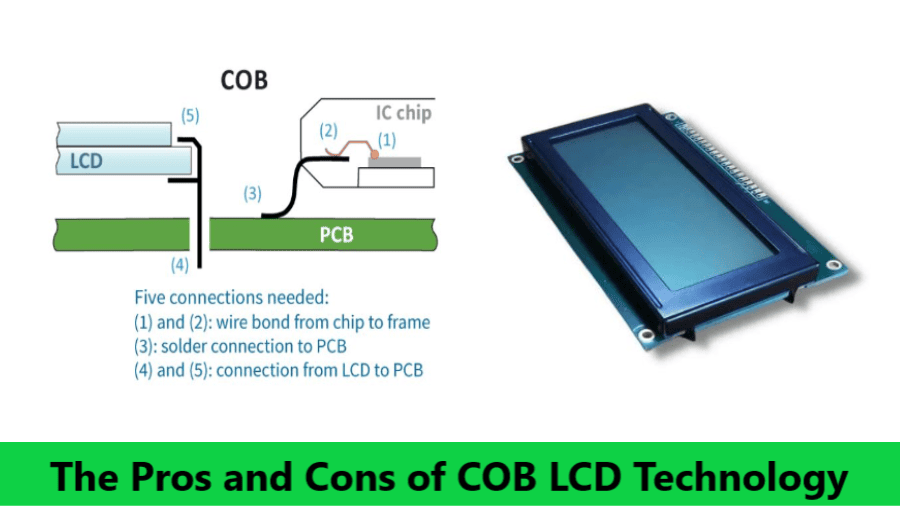
In this article we will discuss in detail on the PROS and CONS of COB LCD Technology. So lets understand what COB LCD Technology is and how it is good to include in your project development. The demand for advanced display technologies is continuously rising. Among the various options available, Chip-on-Board (COB) LCD technology stands out as a promising solution for varied types of applications.
What is COB LCD Technology?
The “COB” stands for “Chip on Board” technology which is a lighting technology which makes use of light-emitting diodes (LCDs).
In SMD (Surface Mount Device) technology, beads are soldered onto the PCB whereas the COB process involves covering the silicon placement point with thermally conductive epoxy resin on the surface of the substrate. And the LCD chip is fixed to the interconnected substrate using conductive or non-conductive adhesive via adhesive or solder. Because of this chip establishes electrical connectivity with the PCB board through lead bonding.
The COB packaging process represents a modern way from traditional packaging technologies reliant on brackets and supports, thereby reducing the number of soldering points.
Understanding COB LCD Technology
COB LCD technology involves mounting the integrated circuit directly onto the glass substrate, eliminating the need for a separate PCB (Printed Circuit Board). This compact design enhances reliability, reduces manufacturing costs, and facilitates miniaturization, making it an appealing choice for numerous electronic devices and integrated displays.
Features of COB LCD Technology
Ultra-micro pitch.
Ultra-clear display screen.
Lighter and thinner box compared to small-pitch LCDs.
Strong heat dissipation with small thermal resistance value.
Reduce moiré effect, offering superior visual experience.
Inconsistent screen color consistency due to small spacing.
Modern packaging methods utilized.
Pros of COB LCD Technology
Enhanced Reliability: The direct attachment of the integrated circuit onto the glass substrate minimizes the risk of connectivity issues and enhances overall reliability. This robust construction makes COB LCD displays ideal for applications requiring long-term durability, for example in automotive instrumentation and industrial control panels.
Space Efficiency: COB LCD technology enables a compact design, making it suitable for devices with limited space constraints. It has a small footprint and simplified assembly process helps in creation of sleek, lightweight products without compromising functionality.
Energy Efficient: COB LCDs have enhanced energy efficiency levels. This advantage comes from the distinctive configuration of COB LCD chips. If your aim is to conserve energy, then COB LCD is the best choice for you.
Customization Options: Manufacturers have flexibility in customizing COB LCD displays to meet customer requirements. From varying screen sizes and resolutions to integrate additional features like touch pads or backlighting, COB technology allows for giving solutions made for diverse applications.
Effective Heat Management: Every LCD produces heat during operation. COB LCDs excel in managing heat efficiently. Their design allows for the flow of generated heat across the module, and also the heat sinks increase thermal regulation. This eventually increases the lifespan of LCD.
Cons of COB LCD Technology
High Cost: There are multiple features COB LCD offers but that come with a higher price compared to traditional LCD options. From manufacturing to packaging and beyond, these LCDs hold a higher cost.
Limited Scalability: While COB technology goes perfect in compact applications, it is not suitable for larger displays due to scalability limitations. As the size of the display increases, the challenges associated with precise circuit placement and thermal management rises, affecting the performance and reliability.
Complex Repair Process: Repairing COB LCD displays is more challenging compared to traditional modules. The integrated circuit which is directly attached to the glass substrate requires specialized equipment and expertise, making repairs potentially more costly and time-consuming.
Susceptibility to Damage: Despite their enhanced reliability, COB LCD displays are more susceptible to damage from mechanical stress or environmental factors. Mishandling during installation or operation can lead to cracked substrates or detached integrated circuits.
Limited Supply Chain Options: Due to the specialized nature of COB technology, manufacturers may face limited options in terms of suppliers and components. This dependency on specific vendors can be challenging in terms of supply chain management and procurement, this impacts production schedules and costs.
Maintenance Difficulties: Repairing LCDs in a COB display has complexities due to the integrated nature of the LCDs and circuits. This can lead to higher repair or replacement costs compared to SMD displays.
Applications of COB LCD Display
Milk Analyzer: COB LCDs are used in an ultrasonic milk analyzer based on the measurement of sound velocity through a milk sample.
Automotive Applications: It is also well-suited for automotive applications enhancing visibility. Their brightness and compact design make them a preferred choice
Weighing Machine: COB Displays are used in a weighing machine that displays the mass of the body by measuring the weight of the body. COB LCDs provide a dependable display solution when reliability and long-lasting performance matters most.
Medical Applications: COB Displays are also used in medical applications including Oxymeter, X-ray device, Angiography device, Blood storage cabinet etc.
COB LCD Display: 16x4(S) COB White/Black Backlight
16x4(S) COB White/Black Backlight Features:
LCD Type: STN- Positive Transflective
Duty: 1/16 and Bias 1/5
Viewing Angle: 6 O'clock
Operating Temperature: -20 to + 70C
Storage Temp: -30 to +80c
Driver IC: ST7066U
Drive Power: Vdd: 5V
Conclusion
COB LCD technology offers multiple advantages for high-resolution displays, particularly in terms of picture quality, contrast, and durability. By carefully considering the pros and cons, you can determine if COB LCD technology is the right choice for your specific needs. Because of increasing applications and development in the Internet of Things, the need for LCD displays is going to increase in the coming future. If you are going to select a LCD Display for your project, consider the COB LCD.

